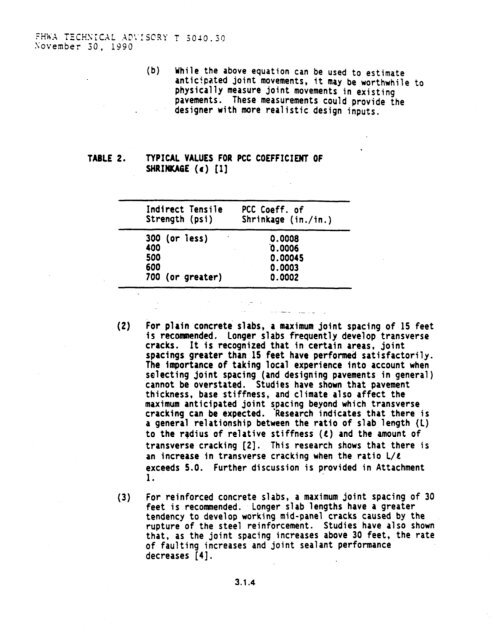chapter 3 rigid pavement - DOT On-Line Publications - Department ...
chapter 3 rigid pavement - DOT On-Line Publications - Department ...
chapter 3 rigid pavement - DOT On-Line Publications - Department ...
You also want an ePaper? Increase the reach of your titles
YUMPU automatically turns print PDFs into web optimized ePapers that Google loves.
Fidh'X TECHSiC.AL .AL1L~!SC!?'r' T SO40.3r3<br />
Sovember 30, 1990<br />
W<br />
While the above equation can be used to estimate<br />
anticipated _- joint movements, it may be worthwhile<br />
physically measure joint movements in existing<br />
to<br />
<strong>pavement</strong>s. These measurements could provide<br />
designer with more realistic design inputs.<br />
the<br />
TABLE 2. TYPICAL VALUES FOR PCC COEFFICIENf OF<br />
SHRINKAGE (a) (11<br />
Indirect Tensile PCC Coeff. of<br />
Strength (psi) Shrinkage (in./in.)<br />
ix; (or less)<br />
500<br />
600<br />
700 (or greater)<br />
0.0008<br />
'0.0006<br />
0.00045<br />
0.0003<br />
0.0002<br />
-- .-. -<br />
(2) Par plain concrete slabs, a maximum joint spacing of 15 feet<br />
is reconunended. Longer slabs frequently develop transverse<br />
cracks. It is recognized that in certain areas, joint<br />
spacings greater than 15 feet have performed satisfactorily.<br />
The importance of taking local experience into account when<br />
selecting joint spacing (and designing <strong>pavement</strong>s in general)<br />
cannot be overstated. Studies have shown that <strong>pavement</strong><br />
thickness, base stiffness, and climate also affect the<br />
maximum anticipated joint spacing beyond which transverse<br />
cracking can be expected. 'Research indicates that there is<br />
a general relationship between the ratio of slab length (L)<br />
to the radius of relative stiffness (C) and the amount of<br />
transverse cracking [2]. This research shows that there is<br />
an increase in transverse cracking when the ratio L/C<br />
exceeds 5.0. Further discussion is provided in Attachment<br />
1.<br />
(3) For reinforced concrete slabs, a maximum joint spacing of 30<br />
feet is recommended. Longer slab lengths have a greater<br />
tendency to develop working mid-panel cracks caused by the<br />
rupture of the steel reinforcement. Studies have also shown<br />
that, as the joint spacing increases above 30 feet, the rate<br />
of faulting increases and joint sealant performance<br />
decreases [4].<br />
3.1.4
















